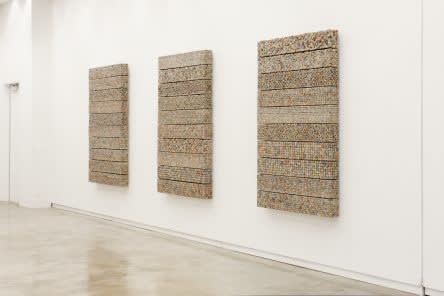When we met Manish Nai last month, his latest work — two paintings and six sculptures — made specially for the Galerie Mirchandani + Steinruecke booth at Art Basel in Hong Kong — was yet to be shipped out. These tall compressions made using diverse materials like newspaper or foam occupied a shop front on the ground fl oor of the building where he lives in Dahisar, Mumbai, attracting the curiosity of passers by. Nai, whose surname bears a reference to the line of barbers he comes from, all originally from the state of Gujarat, spoke to us about how his work is entrenched in the thread business his father used to run, which is where he was first attracted to the texture of jute, a material Nai describes as a humble yarn, used in making gunny bags, packing material, or to cover facades under renovation. “Because my father was a trader of thick jute and other thick cloth material, I visited jute factories, and storage sheds, and I have an intimate understanding of its properties,” Nai told BLOUIN ARTINFO. In 2000, incidentally, the same year that Nai graduated from art school, his father lost the business. At the onset of his artistic career, Nai decided to retain the remembrance of what had past by incorporating the fabric into his art. “In my own way, I’ve continued the family’s connection with this material in my practice.”
Nai’s initial dalliance with jute demanded an intricate process of layering, then drawing over, using projections, and using an implement to snip through the jute weaves to create patterns, almost mimicking the act of trimming hair, as was his ancestors’ original occupation. Nai used to store the jute shavings in a box, and one day, happened to lift the filled-to-capacity container to unearth a square-shaped form made of the leftover jute. This discovery led Nai into working with three-dimension- al forms, and he embarked on his sculptural practice, incorporating into his work a range of material including newspaper, cardboard, and aluminum.
The recent work, particularly the newspaper sculpture, is for Nai, an extension of his obsession with compressing ideas and histories into new forms, and introducing new points of view. “The texture of the folds created by my processes of working with jute opened up further possibilities for me, and I began experimenting with newspaper sculptures,” said Nai. “Under pressure, the rolled-up newspapers begin to resemble a miniature wall made of cement or unevenly cut stone. I find the play between dimensions, materials, and textures set off by these sculptures exciting.”
The indispensability of the newspaper, despite the digital revolution, and the key role it plays in the everyday realities of people, from being the harbinger of news to being a practical item that serves myriad purposes, like selling street food or wrapping objects, are what lured Nai towards incorporating it as a material. Even the dubiousness of news manufacturing becomes a resonant strand when the newspaper gets transformed, at Nai’s hands, into compressed cubes. “A lot of my work is about compression— compressing memories and moments into compact cubic units. Even in the digital world, compressing files is a way to increase the amount of information a machine can hold,” said Nai.
Besides the still undiminished relevance of the newspaper in the 21st century, Nai’s new work also alludes to the medium as an instrument of power. “The way people frame stories and how the facts can be twisted can change history and influence large groups of people,” he said. “When I compress my newspaper works, which come from many different viewpoints and languages within India, propaganda goes away, class difference goes away, religious difference goes away, political difference goes away, all that is left is a form that can be universally understood as compressed history.”
Intriguingly, the booth at Art Basel in HK showcasing Nai’s work has been “curated” by critic Girish Shahane. “The idea of curating an art fair booth is a bit strange,” Shahane replied to our question over an email. “I understand why you put the word in inverted commas. I was doubtful when Usha [Mirchandani] and Ranjana [Steinruecke] first proposed it, and, having come here, I find there are very few booths with independent curators involved. Everybody looks a bit strangely at me when I’m introduced as curator of the booth.” But having now been through the process, from writing the initial proposal to have Nai’s work accepted as part of the “Insights” section of Art Basel in HK to choosing the works to be shown and then arranging the display, and finally, scripting a brief about the show to be given as hand-outs, Shahane made his peace with the word “curator” to describe his involvement. “This show focuses on Manish’s sculpture, a form he has turned to relatively recently,” Shahane wrote. “For a decade he worked almost exclusively in canvas, but in the past three or four years he has branched out to three-dimensional works, murals, and photograph-based prints.”
When Nai wrote to us last night from Hong Kong, he described his current frame of mind as elevated. “I feel a new high through the scale of my experimentation with material and idea, and the two coming together seamlessly,” he said. “It has been a revealing experience for me, this expansion of my repertoire and the responses it has triggered.”

